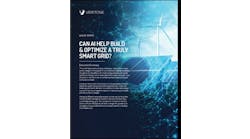Solar eclipse. Courtesy of Sandia National Lab
A Duke Energy microgrid test bed is striving to crack one of the biggest challenges facing utilities today: the need to seamlessly integrate distributed resources and allow for real-time communication between the resources and utilities.
In North Carolina’s Gaston County, at the Mount Holly test bed, Duke is experimenting with ‘Open Field Message Bus Technology,’ a standards-based system that could reduce the complexity and costs of integrating distributed resources. This could be a game changer for the industry, allowing for fast and cost-effective integration of distributed resources.
However, says Tom Fenimore, Duke Energy’s microgrid expert and emerging technology manager, Duke is tackling a huge –and critical — challenge.
“This is an enormous IT and labor challenge — an overwhelming challenge,” he says.
To get a feel for the problem, let’s say Duke is using solar, along with a battery to smooth out the output from the solar.
“If we want to smooth the output of the solar on a distribution circuit, in a traditional situation we have to take data (from the solar panels) out to a data center, make a decision in a computer, and turn around and transmit that out to the battery on a continuous basis,” explains Fenimore. ” By the time you’d get the command out to the battery to smooth out the solar, the solar output would change; you’d always be behind by 10 to 15 seconds.”
That’s a major problem; when clouds cross the solar field, the output can drop to 30 percent in a few seconds, then shoot back up to 100 percent, he explains.
“You can’t respond fast enough with traditional architecture to make fast decisions; you’ll never catch up,” Fenimore says. “In that case, you won’t get the most out of the solar or your battery.”
One of Duke Energy’s goals is to build out a grid with distributed resources, he adds. “One of the challenges of building out a smart grid: We already have a grid and are monitoring hundreds of thousands of devices. Our information is relatively slow; it comes in every few seconds or on the order of minutes. In order to make decisions to optimize the grid, we need to make decisions in real time, in milliseconds in some cases. We just can’t afford the latencies of taking information to a central data center and back out to the field devices.”
The problem, he says, is that the manufacturers of the components that Duke needs to communicate with all use different communications systems; That’s why information is now transmitted to a central data center. The components include protection relays for the grid, energy storage systems, generation equipment, small combined heat and power equipment and other gear.
“Every manufacturer chooses different communication protocols,” Fenimore explains. It’s like trying to drop a Toyota engine into a Ford; they’re not compatible, he adds.
“The communication protocols and the way the vendors choose to map the information are different from one manufacturer to another; S&C Electric and Schneider Electric, for example; each requires a specific way to communicate with their equipment.”
Fenimore adds, “All the vendors have communications methods, but the way the information gets mapped is different. Company A gives information about voltage from its equipment in a different way than Company B.” Even the way the vendors format the information is different, he says.
However, Open Field Message Bus Technology can save the day.
“It takes a step back from the equipment and creates a common industry model for all equipment vendors. There’s a common information model that describes how information is exposed to the network,” he says. With such a system in place, there’s no need to send information to a central data center.
One of the many challenges is to convince vendors to use the protocol. While Duke created the standard, Duke can’t insist that the manufacturers use it, Fenimore explains. “It’s up to the vendors to make their information conform to that model,” he says.
Everyone will benefit from the Open Field Message Bus Technology, Fenimore says. That includes utilities and vendors. What’s more, utility customers would benefit because the grid would include more renewable energy and would run more efficiently.
“It makes this process of communicating with all these devices a seamless effort. It makes the effort more cost-effective and easier,” he explains.
At the Mount Holly test bed, Duke is testing the standards-based system, with about 110 kW of solar and 250 kW of battery storage.
The equipment that’s used in the test bed comes from the “Coalition of the Willing,” a group of about 25 vendors who are allowing Duke to test the system using their equipment. Members of the coalition built the system into their equipment for the purposes of testing it.
“The microgrid gives us a real-world application to test, where we have to have a certain level of performance and speed of data handling,” Fenimore explains.
Duke plans to move out of the lab environment into pre-production testing with the company’s power delivery operation. “We can do some small pilot testing with our operations groups in the next year or two,” says Fenimore. “Beyond that, the roadmap is kind of murky; it’s going to take some successes and exposure.”
One of Duke’s challenges is convincing utilities to embrace the system — and that’s also a big challenge, says Fenimore.
“The utility industry is a conservative industry. There will be some people who kick and scream. That’s the nature of humans,” Fenimore says.
He adds, “We’re still in testing labs and pre-production; I don’t want to be naive that overnight the utility industry will adopt this.”
What are your thoughts about how to bring more standardization to microgrids? Post your comments below or on our Linkedin Group, Microgrid Knowledge.








